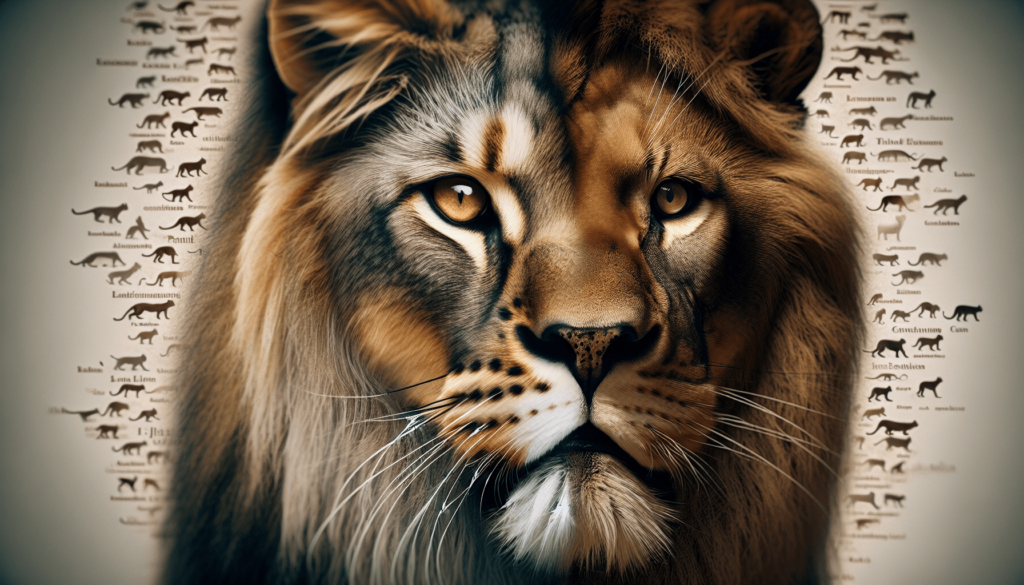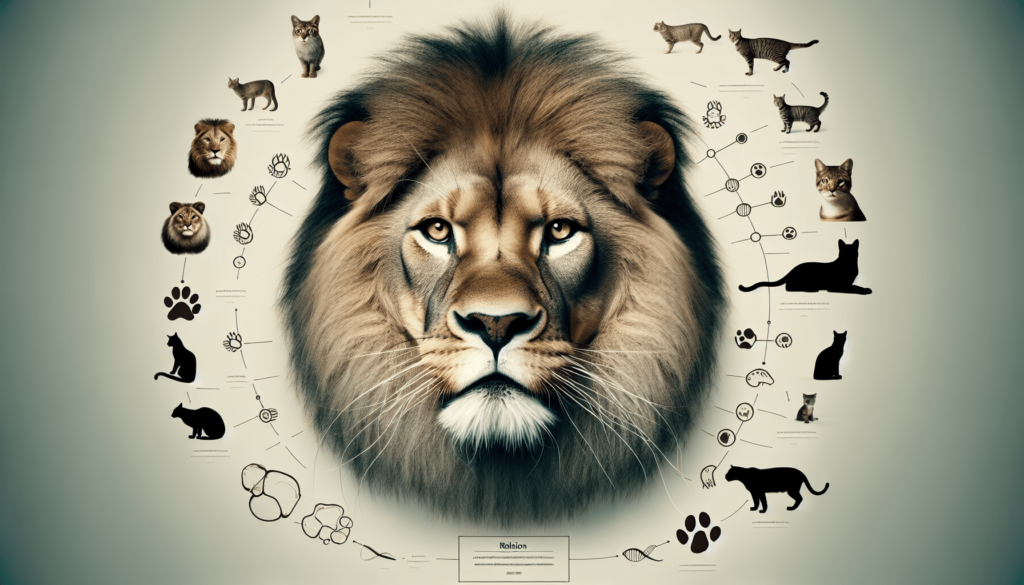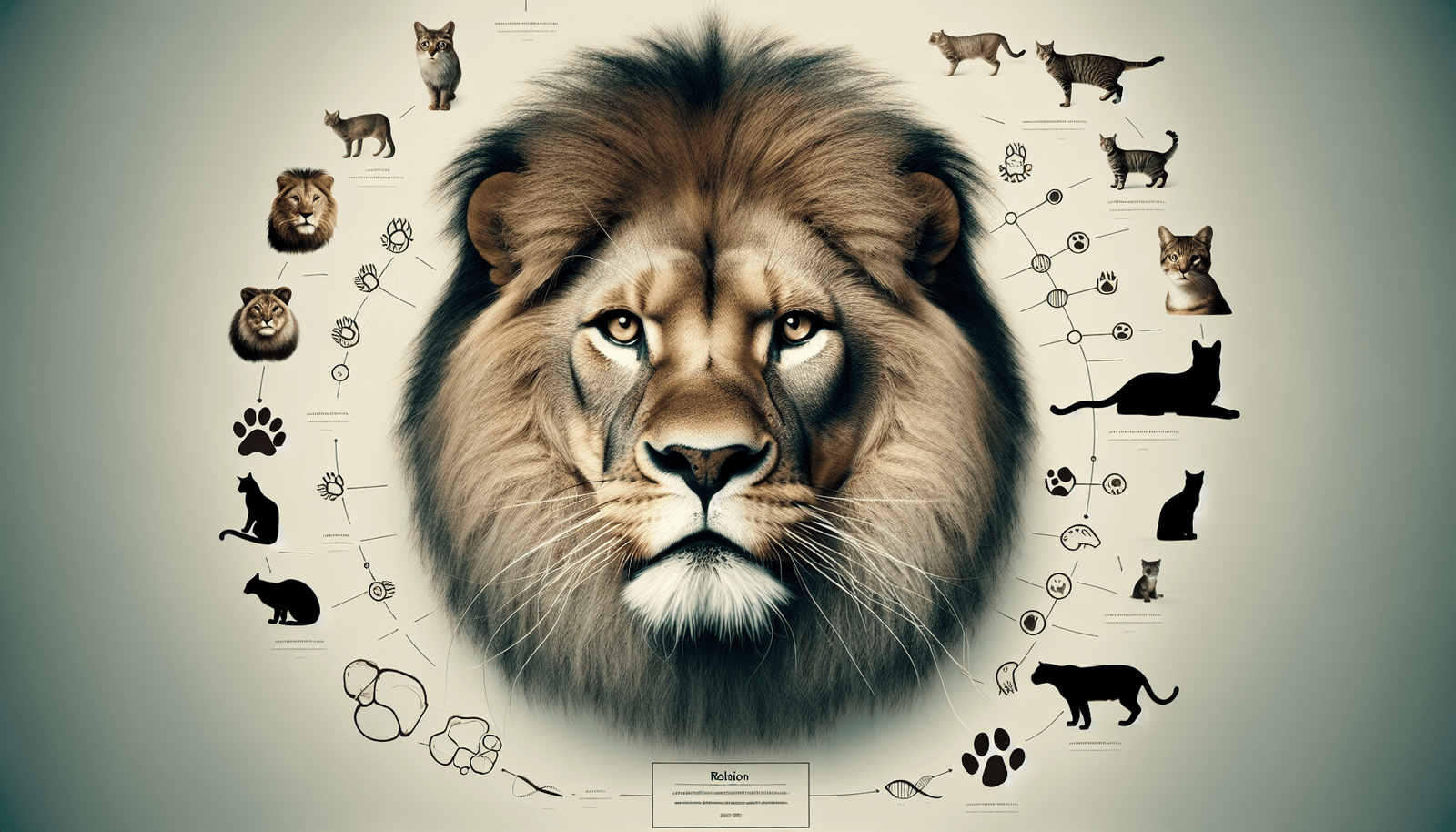Have you ever wondered about the similarities and differences between a lion and a domestic cat? In this article, we explore the intriguing question, “Is a lion a cat?” Whether you’ve pondered this thought before or are simply curious now, join us as we uncover fascinating insights into the relationship between these majestic creatures and their smaller feline counterparts. Let’s unravel the mystery and discover what sets them apart and brings them together.
Definitions and Classification
Understanding Family Felidae
Family Felidae refers to a biological classification that encompasses all the feline species. It includes domestic cats, lions, tigers, cheetahs, leopards, and various other majestic creatures. These animals share common characteristics, making them part of the same family.
Defining the Lion
The lion, scientifically known as Panthera leo, is a large and powerful member of the Felidae family. Known for its majestic appearance and roaring voice, the lion is often referred to as the “king of the jungle.” Lions are native to Africa and have been a prominent symbol of strength and bravery throughout history.
Defining Domestic Cats
Domestic cats, or Felis catus, are small, carnivorous mammals commonly kept as pets. They have been companions to humans for thousands of years and come in various breeds, each with its own unique characteristics. Domestic cats are known for their agile nature, independent personalities, and their ability to form deep bonds with their human companions.
Anatomical Similarities
Facial Structure Comparisons
One striking similarity between lions and domestic cats is their facial structure. Both have a pair of sharp, retractable claws and whiskers that aid in sensory perception. Lions and domestic cats also possess a similar arrangement of facial muscles, enabling them to display a wide range of emotions through facial expressions, such as frowning, snarling, or purring.
Similarities in Body Structure
Although lions are undoubtedly much larger than domestic cats, their body structures share similarities. Both have a flexible spine that allows them to move swiftly and gracefully. Additionally, lions and domestic cats have muscular bodies, equipped for agility and stealthy movements. These similarities highlight their shared ancestry and evolutionary history.
Comparing the Sensory Organs of Lions and Cats
The sensory organs of lions and domestic cats have impressive similarities. Both species have highly developed vision, with eyes capable of perceiving movement in low-light conditions. Their ears are also keenly attuned to detect sounds within their surroundings, enabling them to locate prey or avoid potential dangers. Lions and domestic cats rely on their acute senses to navigate their environment and maintain their survival.

Behavioral Traits
Sleep Patterns of Lions and Cats
Both lions and domestic cats exhibit similar sleep patterns, characterized by intermittent and short periods of sleep. These felines are known as crepuscular animals, meaning they are most active during dawn and dusk. During these hours, lions and domestic cats engage in hunting activities and spend their energy efficiently. The rest of the day is often dedicated to resting and conserving energy for the next burst of activity.
Hunting Techniques of Lions and Cats
Lions and domestic cats both possess natural instincts for hunting. They are skilled predators with sharp claws and teeth designed for capturing and killing prey. While lions exhibit cooperative hunting behaviors, domestic cats primarily rely on their solitary hunting skills. The stalking, pouncing, and ambushing techniques employed by both species demonstrate their shared hunting capabilities.
Social Behavior of Lions and Cats
Lions and domestic cats display varying degrees of social behavior. Lions are highly social animals, living in prides that consist of multiple adult females, their offspring, and a dominant male. They engage in cooperative hunting, protect their territory, and exhibit intricate social hierarchies. In contrast, domestic cats are generally more independent and territorially inclined. While they occasionally form social bonds with other cats or humans, their social behavior is not as elaborate as that of lions.
Genetic Connections
Exploring Genetic Mapping
Advancements in genetic mapping have provided valuable insights into the relationship between lions and domestic cats. DNA analysis has revealed that lions and domestic cats share a common ancestry and belong to the same Felidae family. Their genetic makeup shows similarities that support their classification as feline species.
The Role of DNA in Classification
DNA plays a crucial role in the classification of organisms, including lions and domestic cats. By comparing the genetic sequences of different species, scientists can identify similarities and differences in their DNA. These genetic markers help determine the evolutionary relationships between species, providing evidence for the categorization of lions and domestic cats within the Felidae family.
Historical Evolution from a Common Ancestor
Through extensive scientific research, it has been determined that lions and domestic cats diverged from a common ancestor millions of years ago. Over time, different environmental pressures and adaptations have led to the evolution of distinct traits in each species. Despite these changes, the genetic similarities between lions and domestic cats continuously reinforce their shared ancestry.

Distinctive Features
Unique Physical Characteristics of Lions
Lions possess several distinctive physical features that set them apart from other feline species. One of the most notable features is the majestic mane sported by male lions. This long, thick hair adorning their necks and heads serves as a symbol of dominance and sexual maturity. Additionally, lions have a robust build, with muscular limbs and powerful jaws, making them highly effective predators.
Distinctive Features of Domestic Cats
Domestic cats also have their unique physical characteristics that distinguish them from other feline species. Their compact size, slender bodies, and agile frames enable them to navigate through various environments effortlessly. Domestic cats come in a wide range of coat colors, patterns, and textures, with each breed showcasing its distinct traits and characteristics.
Major Differences between Lions and Domestic Cats
The most apparent major difference between lions and domestic cats is their size. Lions are significantly larger, with adult males weighing up to 550 pounds, while domestic cats average around 10 pounds. Additionally, their habitats and lifestyles also differ. Lions are apex predators, residing in grasslands and savannahs, while domestic cats adapt to various living conditions, including households and urban environments.
Reproduction and Lifespan
Reproduction Cycle in Lions
Lions reproduce through sexual reproduction, with females going through estrus cycles that last for several days. During estrus, females exhibit certain behaviors indicating their readiness to mate, such as increased vocalizations and heightened flirting behaviors. Once impregnated, the gestation period of lionesses is around 110 days, culminating in the birth of a litter consisting of one to six cubs.
Reproduction Cycle in Cats
Domestic cats also reproduce through sexual reproduction. Female cats experience estrus cycles that typically repeat every two to three weeks until they mate or are spayed. Domestic cats are induced ovulators, meaning they ovulate only when they mate. The gestation period for cats is around 63 to 65 days, resulting in the birth of a litter comprising two to five kittens.
Comparing Lifespan and Mortality
Lions have an average lifespan of around 10 to 14 years in the wild. However, in captivity, where they are protected from various threats and have access to specialized care, lions can live up to 25 years. In contrast, domestic cats generally live longer lives, with an average lifespan ranging from 12 to 16 years. Proper nutrition, regular veterinary care, and a safe environment contribute to their extended lifespan.
Diet Habits
Dietary Needs of Lions
Lions are carnivorous predators, feeding primarily on large ungulates such as zebras, wildebeests, and buffalo. Their diet consists of meat, and they require a substantial amount of food to sustain their size and energy levels. Lions have powerful jaws capable of crushing bones and strong digestive systems that can handle high-protein diets.
Dietary Habits of Domestic Cats
Domestic cats are obligate carnivores, meaning they derive their nutrition primarily from animal-based sources. Their diet consists of high-quality commercial cat food or a well-balanced homemade diet. While they share the same carnivorous dietary needs as lions, domestic cats require smaller quantities of food due to their smaller size.
Comparing the Diets of Lions and Cats
While both lions and domestic cats are classified as carnivores, their diets differ significantly due to their contrasting sizes and hunting abilities. Lions primarily feed on larger prey, consuming an average of 10 to 25 pounds of meat per day. Domestic cats, on the other hand, consume much smaller quantities of food, typically around 4 to 6 ounces per day, consisting of smaller animals or processed cat food.
Communication of Lions and Cats
Methods of Communication in Lions
Lions communicate through a variety of vocalizations, facial expressions, and body postures. Their most distinctive form of communication is through roaring, which serves as a means of asserting dominance, defending territories, and attracting mates. Lions also use subtle vocalizations and visual cues to communicate their intentions and maintain social cohesion within their pride.
Methods of Communication in Domestic Cats
Domestic cats communicate through a complex system of vocalizations, body postures, and scent marking. They use meowing, purring, hissing, and growling to express different needs or emotions. Body language, such as tail movements, ear positions, and facial expressions, also play a significant role in their communication. Additionally, cats use scent marking, primarily through rubbing against objects, as a way to establish territory and communicate with other cats.
Similarities and Differences in Communication
While lions and domestic cats share some methods of communication, there are notable differences due to their social structures and environments. Lions, as social animals, rely more on vocal cues and physical interactions within their pride. Domestic cats, being more solitary by nature, communicate through a broader range of vocal and non-vocal cues within their individual territories.
Predator-Prey Relations
Lions’ Relations with Prey
As apex predators, lions play a crucial role in the ecosystem, balancing prey populations and maintaining the natural order. Their hunting techniques involve stalking, chasing, and capturing large ungulates, often relying on teamwork to bring down larger prey. Lions are primarily opportunistic predators, selecting their targets based on availability and vulnerability.
Cats’ Relations with Prey
Domestic cats, while smaller in size, are skilled hunters and have retained their natural predatory instincts. They often target small mammals, birds, reptiles, and insects. Cats use their agility, sharp claws, and keen senses to stalk and capture their prey. In some cases, domestic cats may hunt for sport or engage in play-like hunting behaviors, even when their nutritional needs are met.
Comparing the Prey of Lions and Cats
The prey of lions and domestic cats differ significantly due to their respective habitats and sizes. Lions, being larger and living in the wild, typically prey on large ungulates such as wildebeests, zebras, and buffalo. Domestic cats, being smaller and residing in various environments, primarily target smaller prey like mice, birds, lizards, and insects.
Conclusion: Is a Lion a Cat?
Summarizing the Similarities and Differences
While lions and domestic cats share a common ancestry and belong to the same Felidae family, their differences are apparent. Lions are large, social animals that live in prides, while domestic cats are smaller, more independent creatures often found in households. They exhibit distinct behaviors, hunting techniques, and have varying dietary needs. However, both lions and domestic cats are undeniably feline creatures, possessing unique attributes that make them incredible members of the animal kingdom.
Scientific Classification Review
Scientifically, lions and domestic cats are classified within the Felidae family, indicating their shared evolutionary history. However, they belong to different genera, with lions falling into the Panthera genus and domestic cats belonging to the Felis genus. This distinction reflects the subtle genetic and morphological differences that exist between these feline species.
Final Thoughts on the Comparison
In the grand tapestry of nature, lions and domestic cats exemplify the vast diversity within the Felidae family. While the differences between them are evident, they both captivate our imagination and capture our hearts with their beauty, grace, and unique characteristics. Lions inspire awe with their regal presence and powerful roars, while domestic cats bring joy with their playful antics and the unconditional love they offer. Recognizing and appreciating the individual qualities of lions and domestic cats deepens our understanding and admiration for the incredible world of feline creatures.

